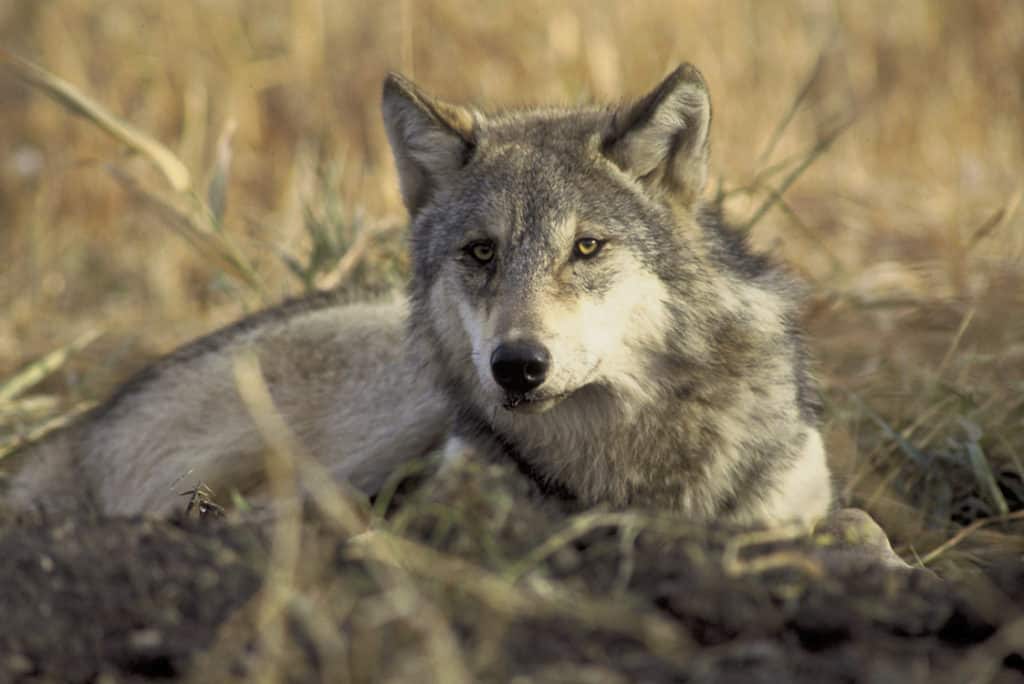
Citizens of many stripes showed up in Hibbing, Minnesota on Tuesday for a hearing about the proposal to remove gray wolves from the Endangered Species list. If the delisting is successful, it could re-open hunting seasons on the wild canines in Minnesota and other states.
The hearing was the only one in the country about the proposed action. Hosted by the U.S. Fish and Wildlife Service, it drew people from Washington, D.C., western states, as well as around Minnesota.
The gray wolf was added to the Endangered Species List in 1974, after decades of open season on the animals. At the time, there were less than 1,000 wolves in the state, with about 250 killed by hunters every year. Today, there are approximately 2,600 wolves in Minnesota — yet they still occupy only about 10 percent of their historic range.
The Minnesota population makes up almost half of the wolves in the lower 48 states. For a species that once numbered in the millions, wolf advocates say this small number is far from fully recovered.
But the increase of wolves in northern Minnesota, while the rest of the state and other areas in the historic range remain uncolonized, has become a fulcrum for the issue.
Passionate points-of-view
The four-hour hearing featured testimony from 81 speakers, with a crowd of 300 people.
Much support for removing wolf protections comes from farmers and ranchers, who lose livestock to the animals. National staff from the U.S. Cattlemen’s Association were in Minnesota for the hearing.
A packed house in Minnesota as @SheepUSA and Minnesota Lamb and Wool Producers speak in favor delisting #GrayWolves and returning them to state management. pic.twitter.com/Uq7cFME4u0
— Public Lands Council (@PLCranching) June 26, 2019
Rancher Joe Webeski of Kittson County, Minnesota testified that he lost 25 percent of his calves to wolf predation last year.
But defenders of wolves in Minnesota believe removing protections would allow their slaughter.
“With state management comes senseless wolf trophy hunting, which is a death sentence for wolves,” said Maureen Hackett, founder and president of Howling For Wolves, in a statement. “Killing wolves harms their pack structure and genetic diversity. With federal protections, we can ensure survival of wolves for future generations.”
Wolf defenders also say delisting them would stymie efforts to expand wolf ranges into additional suitable habitat, including the Adirondacks and southern Rocky Mountains.
“We’ve come a long ways, but what all has been accomplished is not secure, nor is it enough,” said Peter David of the Great Lakes Indian Fish and Wildlife Commission. “The recovery of wolves on this broader landscape cannot be measured just by what we witness in our backyard.”
Questions about science
Advocates for removing wolves from the Endangered Species List say studies have shown the goals of federal protection have been met over the past several decades.
““We need to make sure we’re applying sound science to these issues,” said Tanner Beymer of the National Cattlemen’s Beef Association. “Wolves have recovered and it’s time for them to come off the list.”
But the science is not as settled as some say.
Shortly before the hearing, the U.S. Fish and Wildlife Service released a document of peer review of its proposal. With independent input from researchers and other professionals around the country, the process is intended to root wildlife policies in sound science. The five-person panel that conducted the review found it failed in a number of ways.
“It looks like they decided to delist and then they compiled all the evidence that they thought supported that decision. It simply doesn’t support the decision,” said Adrian Treves, an environmental studies professor at the University of Wisconsin.
The public comment period for wolf delisting is open until July 15. Click here to learn more and submit your own comments.
More information
- National interests converge on Brainerd in US’s only gray wolf delisting hearing – Brainerd Dispatch
- Hearing on wolves’ protected status draws large, passionate crowds – MPR News
- Removing the Gray Wolf (Canis lupus) from the List of Endangered and Threatened Wildlife
- Summary Report of Independent Peer Reviews for the U.S. Fish and Wildlife Service Gray Wolf Delisting Review (PDF)

